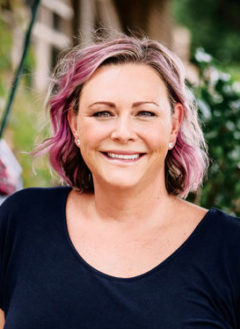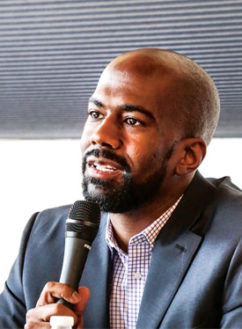
Amanda Sawyer represents District 5; Chris Herndon represents District 8

Amanda Sawyer was elected to represent District 5, which includes Lowry, Montclair, Hale, Hilltop, Washington Virginia Vale, East Colfax and East Windsor.
Incoming City Council Member Amanda Sawyer ran on a platform that opposed Denver’s rapid growth, and is especially interested in slowing development in District 5, which includes Lowry, Montclair, Hale, Hilltop, Washington Virginia Vale, E. Windsor, and E. Colfax. “People are really ready to have more of a voice,” Sawyer says. She plans to be that voice for her constituents once she takes office in mid-July.
While Sawyer appreciates the need for greater housing density in Denver, she also understands that for many of her supporters, their spacious lots in low-density parts of the city are the result of years of aspiring to home ownership in just such a setting. “I see my role as being an advocate for the people and what changes they would like to see in our community. That means going to them and figuring that out and then going to the City and…getting it done.”
Sawyer seems reticent to support greater housing density in her district, arguing that a lack of sidewalks and transportation infrastructure makes increased housing density not only untenable but also imprudent. As during her campaign, she emphasizes the need for a dedicated source of funding in the City of Denver to support public transit, protected bike lanes, and other alternatives to cars. “The single biggest problem we face in our district is the absence of transit and mobility infrastructure support…without the money nothing is happening.”
Still, she recognizes the need for additional housing options, especially as homeowners age. “In District 5 there’s a real problem for people aging in place; they are ready to leave large single-family homes, but there are few places to live on a fixed income….that’s a challenge. In my opinion we’ve tried to build our way out of it and that’s not the answer.”
“Some form of inclusionary zoning or upzoning to incentivize developers…is probably going to have to happen to fill in that missing middle. I don’t know exactly what that solution looks like,” says Sawyer.
Within District 5, she offers up the E. Colfax area as the most propitious for upzoning, though she does express concern about maintaining neighborhood character as buildings get taller.
When asked how she will work with other members of the City Council, Sawyer defers, saying she has not yet met with her new co-workers. Asked about areas she might find room for compromise with Mayor Michael Hancock, she says, “I haven’t had time to sit down with him yet….we both love this city….There’s a lot of room for compromise there….we’re going to have some tough discussions and get into the nitty-gritty.”
Growth of cities and its impact on housing is a big subject in the news these days. San Francisco is cited as a city that has become affordable only to the wealthy. And Minneapolis is now being recognized nationwide as the city that just made a bold move to make housing affordable in all its neighborhoods.

Chris Herndon represents District 8, which includes Park Hill, Stapleton and parts of Montbello and East Colfax.
Councilman Chris Herndon, just re-elected to his third and final term, says Denver is handling growth “in a responsible manner.” Minneapolis’ bold plan was to “upzone” most single-family zoning to three units per lot. Herndon says he views Minneapolis as taking away something (single family zoning), whereas Denver is adding options. Denver’s recently approved Comprehensive Plan 2040 adds opportunities for growth throughout the city using what is being called “gentle zoning.”
“With this new approach we’re saying our city is evolving and neighborhoods can evolve as well, but we can evolve and at the same time ensure that we’re protecting the character and vibrancy of our neighborhoods. The strategy is to create a greater mix of housing options for individuals and families…[so] each and every neighborhood can evolve to add to the growth that’s happening in our city.”
For example, a larger house on a larger lot, could, with the exact same footprint, become a duplex or a triplex. “If you’re driving through the neighborhood, you still see one unit. That’s an example of gentle density where a neighborhood can embrace more population coming to our city and at the same time maintain the same character and vibrancy,” says Herndon.
Another example is accessory dwelling units (ADUs). A dwelling unit can be put over the garage of a single family home, allowing that homeowner to have additional income. Or someone who wants to downsize could move into the ADU. “That’s a tool we’re using that can help neighborhoods allow more people and at the same time allow people to generate income.”
With Comp 2040, ADUs are now allowed throughout the city. Some neighborhoods are already zoned for ADUs; in others a zoning variance would be required. In neighborhoods already zoned for ADUs, a homeowner can get a building permit and proceed. In neighborhoods not currently zoned for ADUs, Community Planning and Development would make a recommendation based on the criteria in the Comp Plan. Neighborhood organizations give input, but, Herndon says, “If individuals come to us and say, ‘I object for reasons outside the criteria,’ it would be hard for me as a council person to support that because we are beholden to the criteria that are before us.”
The counter to density is sprawl, says Herndon, and then people have longer commute times. “If you’re objecting to density, you’re going to increase traffic and decrease affordability as well…On East Colfax, we’re adding density along the corridor, but we have alternative modes of transportation. The assumption people will be coming in single occupancy vehicles, I would say, is not entirely accurate because we’re providing you a more convenient method for getting from East Colfax to downtown as the bus rapid transit comes along. We, as a city, are being thoughtful about providing alternatives to being in your car; we have bike lanes throughout the city; the A Line is successful.
“We have to make sure we find the balance, because if we don’t plan, it’s not going to stop people from coming.”



0 Comments